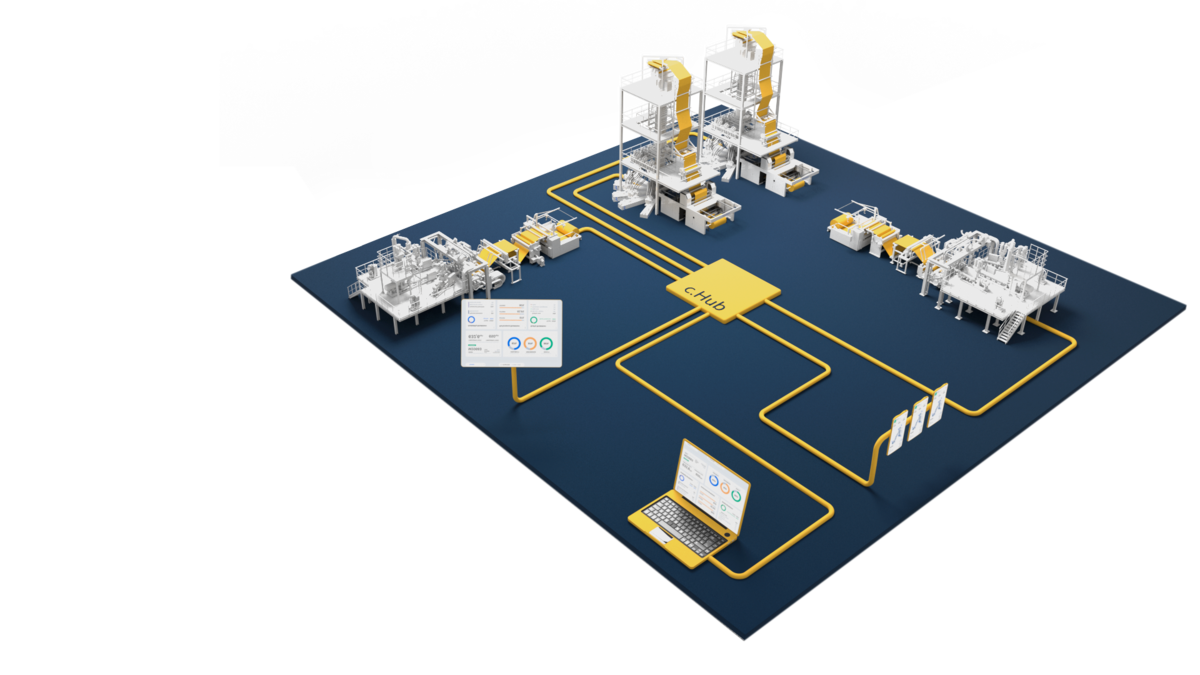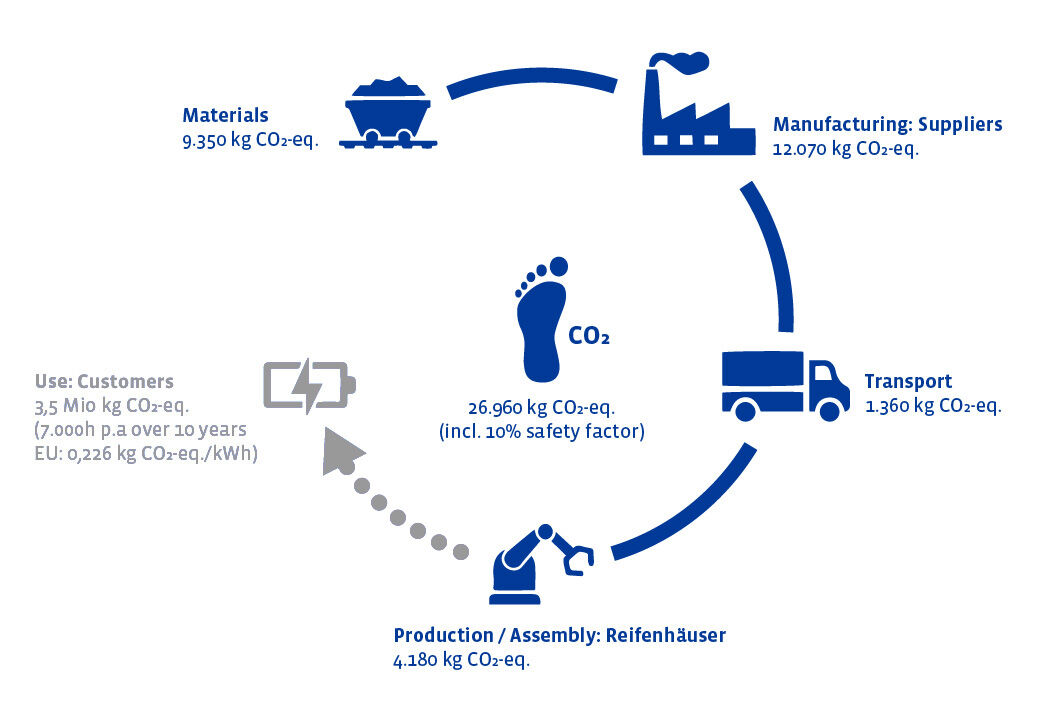
Combining economic efficiency with sustainability - Carbon footprint calculation makes it possible
Reducing greenhouse gas emissions that are harmful to the climate is the order of the day - also in the production of films and nonwovens. The calculation of the carbon footprint helps manufacturers to identify emission sources and to make transparent where the greatest levers for reducing the CO2 footprint lie. The challenge here is that carbon footprint accounting is quite complex. This starts with the different methods used to calculate it:
What is the Corporate Carbon Footprint (CCF)?
The Corporate Carbon Footprint (CCF) balances the CO2 footprint for the entire company - from energy procurement and production to the company's vehicle fleet.
What is the Product Carbon Footprint (PCF)?
The Product Carbon Footprint (PCF) captures all CO2 emissions that occur along the life cycle of a product, i.e. from raw materials to production and use to disposal.
Whether CCF or PCF - the consideration of climate and environmental impacts will take on a greater role in the future, partly due to legal requirements and driven by consumers' desire for sustainable products. Manufacturers of films and nonwovens can approach the calculation "bottom down" via a Corporate Carbon Footprint or "bottom up" via a Product Carbon Footprint for each of their products. The latter is ideal when a broad product portfolio with different raw materials and recycled content is processed. "As a plant manufacturer, we support our customers in taking the first step towards a Product Carbon Footprint," says Dr. Tim Pohl, responsible for Sustainability and New Business Development at Reifenhäuser.
On the one hand, Reifenhäuser can provide an estimate of the carbon footprint of the extrudate on the roll; on the other hand, Reifenhäuser knows the product carbon footprint of the extrusion components screw, barrel and even the entire extruder. "The information is intended to help our customers understand the emission sources in their production," explains Dr. Pohl, "and thus contribute to developing more sustainable products on our extrusion lines."
Here's how: Determine the carbon footprint of film or nonwovens
All lines with Reifenhäuser's digital platform c.Hub already have a "Sustainability Dashboard" as a standard function. "This allows our customers to see how the carbon footprint is changing in the ongoing production of their film or nonwoven and draw conclusions on how to improve their carbon footprint," explains Dr. Pohl. The data includes, for example, energy consumption and raw material usage. It is also possible to display the CO2 equivalents for a roll produced.

The carbon footprint calculation is carried out via Reifenhäuser's digital platform c.Hub, which connects extrusion lines of a production vendor-independent and compiles the required data.
In the basic version of the "Sustainability Dashboard", customers receive a carbon footprint benchmark based on real energy and raw material consumption values. If desired, this guideline value can be adapted to the respective customer boundary conditions, for example with regard to individually used polymers as well as local energy sources. "This then makes it possible to make individual statements about the carbon footprint of a single roll - instead of looking at an entire production site, as is often the case today," explains Dr. Pohl. "The estimation becomes exciting when customers want to show the carbon footprint to third parties and have a particularly sustainable product line certified."
Life cycle analysis (LCA)
Reifenhäuser has already developed a generally applicable calculation method for creating a life cycle analysis (LCA) in 2019 in cooperation with the Institute for Plastics Processing, Aachen. The LCA contains all relevant energy and material flows along the life cycle of plastic extrusion products. Feel free to contact us if you would like to learn more.
Comparing emission sources in production
Reifenhäuser has also balanced the product carbon footprint of extruders, barrels and screws: from the steel used, to the components supplied and their transport, to production at Reifenhäuser and the subsequent use phase. "These values can be included in our customers' PCF calculations, for example when calculating the PCF of an injection molding machine," says Dr. Pohl."
To make values comparable with other products, the PCF is uniformly expressed in kilograms of CO2 equivalents. One CO2 equivalent corresponds to one emitted ton of carbon dioxide (CO2).
The production of an extruder generates a calculated one-off amount of around 27,000 kilograms of CO2 equivalents. In contrast, the operation of the extruder causes around 3.5 million kilograms of CO2 equivalents through electricity consumption over the course of ten years. This means that for an extruder, the manufacturing process causes less than one percent of the PCF along the life cycle. In contrast, 99 percent is generated during the use of the extruder. "The leverage for reducing emissions in the use phase is therefore much higher," explains Dr. Pohl.
Data sources Product Carbon Footprint
There are various approaches for calculating a product carbon footprint. For example, the DIN EN ISO 14067 standard serves as a guideline. Primary data from Reifenhäuser's production were available for the balancing of screws and barrels. In addition, secondary data from databases and studies were used, and comprehensible assumptions were made. Please contact us if you would like to learn more about the data basis of our calculation.
Carbon Footprint Calculation of a Reifenhäuser Extruder

Reducing carbon footprint in plastics extrusion.
"The comparison of emission sources shows that energy-efficient plant technology is worthwhile in order to reduce emissions and usually also costs," says Dr. Pohl. Levers include energy-efficient drive technologies or individual screw designs that melt material with the lowest possible energy input. There are also special energy-saving packages for spunbond lines, for example. "The optimum package depends on the range of raw materials processed and the desired end product properties - we advise our customers to match the requirements of their production," says Dr. Pohl.
An investment in energy-efficient line technologies not only reduces the carbon footprint, but is also economically worthwhile - especially in view of the currently rapidly rising energy prices: "What used to pay for itself in two to three years now sometimes pays for itself in just a few months," emphasizes Reifenhäuser's sustainability expert.